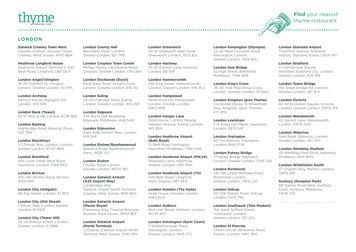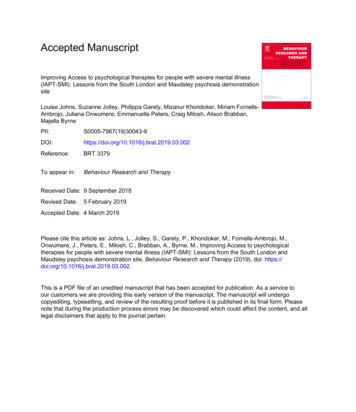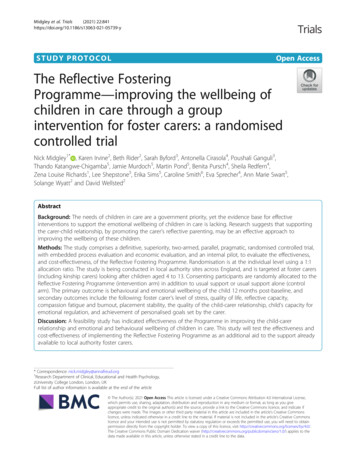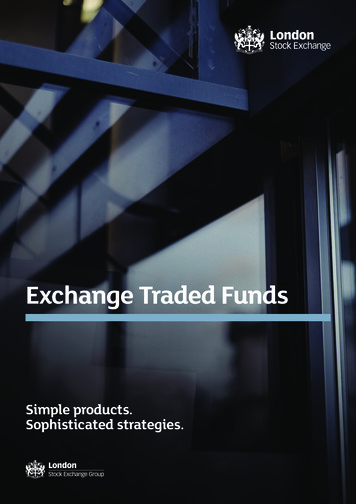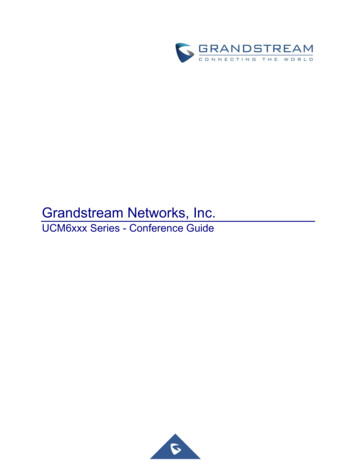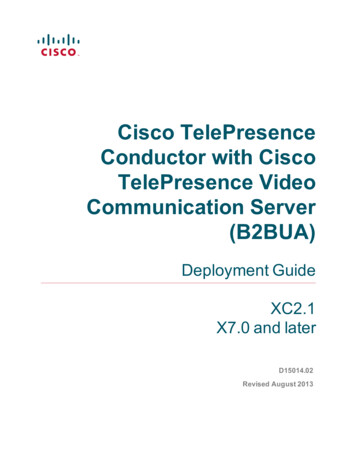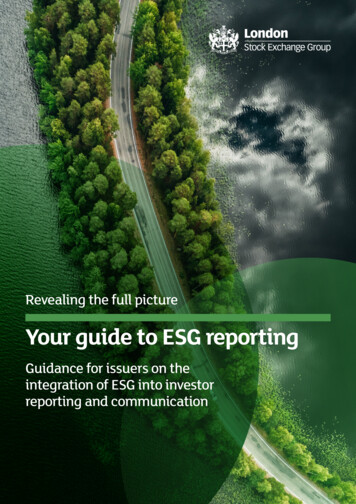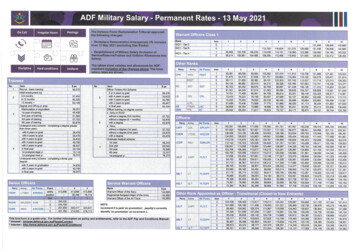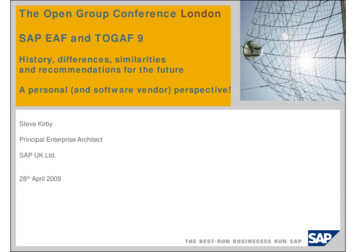
Transcription
The Open Group Conference LondonSAP EAF and TOGAF 9History, differences, similaritiesand recommendations for the futureA personal (and software vendor) perspective!Steve KirbyPrincipal Enterprise ArchitectSAP UK Ltd.28th April 2009
Assumptions and objectives for this session Assumptionp– this audience understands the basics concerning:g What is Enterprise Architecture?What is an EA framework?What is TOGAF? Objectives: Provide a short background to TOGAF 88.11 and SAP EAF Explain the major differences and similarities between SAP EAF and TOGAF 9 Discuss personal recommendations for TOGAF 9.1, 10 etc. SAP 2008
Agenda1.12.33.4.Background to TOGAF 8.18 1 and SAP EAFTOGAF 8.1 and 9Major differences and similarities between SAP EAF and TOGAF 9Recommendations for TOGAF 9.1, 10. SAP 2008
A short history of TOGAF up to version 8.1The Open Group Architecture Framework Originated from US DoD Technical Architecture Method for Information Management(TAFIM) TAFIM 3.0 ownership moved from DoD to The Open Group in 1995, renamed to TOGAF New versions were originally developed and released approximately each year First 7 versions focussed on IT Architecture only Version 8.0 extended into Enterprise Architecture by adding Business Architecture domain Version 8.1 released at the end of 2003 ConsideredCid d a reliable,li bl proven methodh d ffor ddevelopingl i EEnterprisei AArchitecturehiandd consideredid dto be the de facto market leader for Enterprise Architecture frameworks An openp standard but with strict license gguidelines i.e. if yyou are developingp g EnterprisepArchitecture for a customer using TOGAF you must have either a commercial license or bea member of the Open Group Architecture Forum Vendor neutral,neutral not industry specificspecific, applicable for enterprises of any size or location Intended to be tailored with a focus on method (‘how’) rather than deliverables (‘what’) SAP 2008
From TOGAF 8.1 to SAP EAF SAP EnterprisepArchitecture team set upp in Augustg2006 Enterprise Architects (mostly external to SAP) were recruited in 3Q and 4Q 2006 Discussions with Capgemini in 4Q 2006 for a joint EA Framework development Development started in January 2007 and completed in April 2007 LLaunchedh d simultaneouslyi ltl att SSapphirehi anddOOpen GGroup conferencesfAAprilil 2007 SAP EAF content made publicly available and released to the Open Group Successful customer pilot in UK June/July 2007 SAP EA Services, SOA200 training course and Associate SAP EA certificationddevelopedld iin 2Q 2007 Over 50 SOA200 training courses have been run globally – many hundreds ofpeople have been trained in SAP EAF and certified as Associate SAP EAs SOA200 is now SAP’s second most popular training course worldwide! SSuccessfulf l adoptiond ti off SAP EAF byb majorj SAP customerstandd many successes SAP 2008
SAP EAF Mission Statement“SAP Enterprise Architecture Framework isan extension of the TOGAF Frameworkspecifically designed to support the effectiveadoption of packaged solutionsin the Service-Oriented Enterprise”Collaboration between SAP and Capgemini –working under the guidance of the Open Group Vision, strategic product knowledge, initiative leadership (SAP) ExperienceEiini EnterpriseE ti ArchitectureA hit tFrameworkFk DevelopmentDlt anddexperience of working with the Open Group (Capgemini) Integration with EA Tools and SAP-specific content (SAP and IDS Scheer) StandardsSd d andd foundationfd i – OpenOGroupG(Architecture(A hiForum)F) SAP 2008
What is Actually In SAP EAF?SAP EAFSAP Specific ToolsSAP ContentTools(e.g. Solution Composer, RoadmapComposer, SAP Service Workplace)EA ModellingTools(e.g. IDS Scheer)SAP ImplementationTools(e.g. Solution Manager, SystemLandscape Directory)Supplier Independent FrameworkTemplates, Examples and Case StudiesArchitectureDevelopment MethodSAP BusinessReference ModelsContentMetamodelUsage GuidelinesTOGAF Architecture Development Method SAP 2008Resource BaseSAP TechnologyReference ModelsTOGAF Resource BaseReleaased to the OOpen GroupReleaased to the OOpen GroupSAP-Specific Mappings
Agenda1.12.33.4.Background to TOGAF 8.18 1 and SAP EAFTOGAF 8.1 and 9Major differences and similarities between SAP EAF and TOGAF 9Recommendations for TOGAF 9.1, 10. SAP 2008
TOGAF 8.1.1 Content OverviewTOGAF 8.1.1 – 349 pages of content Part I: Reference models and InformationBases Part II: Building blocks & EnterpriseContin mContinuum Develop a consistent and comprehensive modelShow multiple views to communicate the modeleffectivelyPart III: Architecture Development Method Technical Reference ModelApplication Architecture Reference ModelStandard Information BaseCore of TOGAF. Step by step guidelines to developenterprise architecturePart IV: Resource base to supportpp theADM SAP 2008Tools & TechniquesArchitecture Practitioner Conferences
TOGAF 9 Content OverviewTOGAF 9 – 744 pages of content! Part I: Introduction Part II: Architecture Development Method Part III: ADM Guidelines & Techniques Taxonomies and tools to categorize and store outputof architecture activitesPart VI: TOGAF Reference Models Structured metamodel for architectural artifacts andoverview of typical architectural deliverables.Part V: Enterprise Continuum & Tools Collection of guidelines and techniques applicable toTOGAF and the ADMPart IV: Architecture Content Framework Core of TOGAFTOGAF. Step by step guidelines to developan enterprise architecture.TOGAF Foundation Architecture, TRM, III-RMPart VII: Architecture CapabilityFramework Organization, processes, skills and roles required tooperate an architecture function within an enterprise.Summary SAP 2008 Parts III, IV and VII are the sections containing the most significantfnew content Most of the additional elements in Part II, III and IV were taken directly from SAP EAF
Summary - SAP EAF has contributed manysignificant additional elements to TOGAF 9.0SAP ExtensionsStandardsTOGAF 8.1 SAP 20082002EAFTOGAF 920072009
Agenda1.12.33.4.Background to TOGAF 8.18 1 and SAP EAFTOGAF 8.1 and 9Major differences and similarities between SAP EAF and TOGAF 9Recommendations for TOGAF 9.1, 10. SAP 2008
Part III – ADM Guidelines and TechniquesA recap on the TOGAF ADMTOGAF 88.1,1 SAP EAF and TOGAF 9.090 Preliminary PhasePhase A: Architecture VisionPhase B: Business ArchitecturePhase C: Information System ArchitecturePhase D: Technology ArchitecturePhase E: Opportunities and SolutionsPhase F: Migration PlanningPhase G: Implementation GovernancePhase H: Architecture ChangeManagementRequirements ManagementSummary SAP 2008 The essence of the TOGAF 8.1 ADM (the wheel) is retained in TOGAF 9 New SAP EAF concepts such as Iteration Cycles and Process Styles (As-Is or To-BeFirst) have been carried forward directly and without change into TOGAF 9
The concept of Iteration Cycles introduced in SAP EAFhas been carried forward directly into TOGAF 9ArchitectureContext onPlanningIterations SAP 2008ArchitectureDefinitionItIterationsti
The concept of Process Styles (As-Is or To-Be first)introduced in SAP EAF has been carried forward directlyinto TOGAF 9ArchitectureContextSAP EAF PhaseInitial IterationArchitecture DefinitionTransformation PlanningIteration 1Iteration 2Iteration nIteration 1Iteration nArchitecture DeploymentIteration 1Iteration InformalCoreCoreInformalInformalLightA IAs-IsI fInformallCCoreLi htLightCCoreI fInformallI fInformallLi ightTo pportunitiesOppotu t es aandd SoSolutionsut o lMigration oreLightBusiness ArchitectureApplication ArchitectureData ArchitectureTechnology ArchitectureImplementation GovernanceChange Management SAP 2008InformalInformalCore primary focus activity for the iterationg secondaryy focus activityy for the iterationLightInformal potential activity in the iteration, not formally mentioned in the methodInformal
More practical guidance has been added tothe new TOGAF 9.0 phase descriptions Phase 0: Preliminary PhaseSimilar to EAF, some new conceptsPhase A: Architecture VisionSimilar to EAF, some new conceptsPhase B: Business ArchitectureSimilar to EAF, same viewpointsPhase C: Information System ArchitectureSimilar to EAF, same viewpoints, genericPhase D: Technology ArchitectureSimilar to EAF,EAF same viewpoints,viewpoints generic Phase E: Opportunities and SolutionsSignificantly improved over 8.1 and EAF Phase F: Migration PlanningPhase G: Implementation GovernancePhase H: Architecture Change ManagementSignificantly improved over 8.1 and EAFDifferent from EAF, very light in contentSimilar to EAF Requirements ManagementSimilar to EAF,EAF very light in content SAP 2008
There are some differences from SAP EAF toTOGAF 9 at an overall level and within each phasep Conduct Formal Stakeholder Review steps remain in each of phases B, C and Dfor TOGAF 9. SAP EAF recommends only having a formal stakeholder review atthe end of each major Iteration Cycle (i.e. at the end of Phase D) so as to avoidthe implication that the TOGAF ADM is a ‘waterfall’ approach.TOGAF 9 remains unclear as to whether Application or Data Architecture shouldbe defined first within phase C Information Systems Architecture. SAP EAFrecommends definingg Application Architecture before Data Architecture.Following phase B, the approach, inputs, steps and outputs defined for phases Cand D for TOGAF 9 are highly repetitive, somewhat generic and lacking specificpractical gguidance.and pThe incremental approach taken to the definition of inputs and outputs (i.e. theoutputs from earlier phases are always used as inputs to subsequent phases)leads to long and repetitive checklists rather than highlighting new phase-specificphase specificdeliverables.Significant improvements have been made by Capgemini to address the lack ofcontent in phases E and F which were very light in TOGAF 8.18 1 and SAP EAFEAF.Phase G has also been changed by Capgemini to address the lack of content inTOGAF 8.1 and SAP EAF but it remains light and a potential improvement area. SAP 2008
There are numerous elements in the TOGAF 9 ADMthat will be familiar to SAP EnterprisepArchitects! The basic TOGAF approach to defining the overall approach, inputs, steps to becarried out, and outputs for each phase has been followed, and more narrativesteps and practical guidance can be found in TOGAF 9 compared with TOGAF 8.1The conceptp of Catalogs,g , Matrices and Views ((Diagrams)g) introduced in SAP EAFand their definition and production within the ADM have been carried forwarddirectly into TOGAF 9The Catalogs, Matrices and Views (Diagrams) recommended for production duringPhases B, C and D in TOGAF 9 are almost identical to those defined in SAP EAF.Many of the new concepts, accelerators and templates introduced in SAP EAFhave been carried forward directly into the TOGAF 9 narratives ee.g.g Principles catalog, template and examples (Phase 0 - Preliminary) Stakeholder map and template (Phase A – Architecture Vision) Business capability assessment (Phase A – Architecture Vision) Types of architecture engagement (Phase A – Architecture Vision) Service contracts (Phase B - Business Architecture) Classification of changes (Phase H - Architecture Change Management)Many of the individual narrative steps and descriptions from SAP EAF phaseshave been carried forward directly into TOGAF 9 and will be recognisable to SAPEnterprise Architects and SAP customers trained and certified in SAP EAF SAP 2008
ConsumesPart IV - Architecture Content FrameworkA recap on the SAP EAF MetamodelContainsContainsContainsContainsIs guidedbyOrchestrates,decomposes SAP 2008 / Page 19
Part IV - Architecture Content FrameworkThe TOGAF 9 metamodel looks very familiar! SAP 2008
At last, a TOGAF metamodel, with only minordifferences to the SAP EAF metamodel! TOGAF 8.1 had no formal, clearly-defined metamodel.The metamodel introduced in TOGAF 9 is based entirely on the SAP EAFmetamodel with minor differences, one of which is significant and erroneous!TOGAF 9 retains the SAP EAF concept of ‘core’core and ‘extension’extension entities.entitiesThe major difference is that TOGAF 9 has the Drivers, Goals and Objectivesentities defined as Motivation Extension entities – in SAP EAF these are core.We believe this is incorrect and leads to the strong possibility of IT-focusedarchitecture definition in isolation i.e. without appropriate business context andalignment!TOGAF 9 introduces the Capability entity which has a relationship to the WorkPackage entity. This entity is defined in Phase E. All other core and extensionentity definitions and relationships are carried forward from SAP EAF to TOGAF 9.Th Business/ITTheB i/IT AlignmentAlit extensionti ini SAP EAF hhas bbeen renamedd ththe SServicesiextension.The TOGAF 9 metamodel diagram more clearly shows a separation between theBusiness ServiceSand InformationfSystemSServiceSentities.TOGAF 9 defines optional attributes for some but not all metamodel entities thaty usingg an Enterprise Architecture tool.can be captured and reported on, ideally SAP 2008
Key EAF entity relationship discussions have beencarried forward into TOGAF 9 - including errors!SAP EAFTOGAF 9Business Service entities shown above within the ApplicationComponent entities are actually Information System Services! SAP 2008
Catalogs, Matrics and Views.or Diagrams! The concept of Catalogs, Matrices and Views introduced in SAP EAF has beencarried forward to TOGAF 9 but please note that Views are now called Diagrams(definition: both are renderings of architecture content in diagrammatic format!)TOGAF 9 defines Views as “a representationpof a systemyfrom the pperspectivepof arelated set of concerns” while Viewpoints “define the perspective from which aView is taken”. Catalogs, Matrices and Diagrams are used to provide Viewpoints.Almost all of the set of Catalogs, Matrics and Views (Diagrams) provided with SAPEAF have been carried forward into TOGAF 9 with some additions: TOGAF 9 adds a Product Lifecycle Diagram to Business ArchitectureTOGAF 9 adds a System/Use Case Diagram to Application ArchitectureTOGAF 9 has a Benefits Diagram for Opportunities and Solutions instead of a PortfolioViewTOGAF 9 has a Class Diagram for Data Architecture instead of a Conceptual/Logical ERViewAll of the above are Core diagramsSAP EAF provides detailed descriptions of the purpose and content from ametamodel entity perspective of the various Catalogs, Matrices and Diagrams tobe produced. These descriptions have been carried forward to the TOGAF 9Architecture Content FrameworkFramework. SAP 2008
Metamodel Extensions from SAP EAF to TOGAF 9 one renamed and one new ((that we do not like!))EAFTOGAF 9 SAP 2008
There is significant new material to be found in theADM Guidelines & Techniquesqarea of TOGAF 9TOGAF 9 Part I: Introduction Part II: Architecture Development Method PartP t IIIIII: ADM GuidelinesG id li& TechniquesT h i ADM at different entprise levelsSecurity Architecture in the ADMRisk ManagementApplying the ADM at Different Enterprise LevelsSecurity Architecture in the ADMUsing TOGAF to define and govern SOAsArchitecture PatternsBusiness ScenariosMigration Planning Techniques Part IV: Architecture Content FrameworkInteroperability Requirements Part V: Enterprise Continuum & ToolsBusiness Transformation Readiness Assessment Architecture PartitioningArchitecture Repository Part VI: TOGAF Reference Models Part VII: Architecture CapabilityFramework SAP 2008Architecture CapabilityRisk ManagementCapability-Based PlanningSummary – there are many significant anduseful discussion materials on above topicsdelivered in a modular fashion
There are numerous elements exclusive toSAP EAF that are relevent for TOGAF 9EAF SAP Mappings SAP Tooling SAP Services SAP Mappings Mapping of EAF terminology (based on TOGAF) to theSAP taxonomy used within SAP products and tools Specific mappings of SAP product and tool content to theEAF metamodel Mappings of SAP products and tools to the TOGAF TRMSAP EA Education & CertificationSAP ToolingT li Evaluation guide for EA tools Metamodel implementation in ARIS IT Architect Integrationteg at o to SAPSSolutionSo ut o Managera age / ESRSSAP Services Aligned to EAF methodology for specific customer needs EA Value & Vision EA Maturity Assessment EA Quickstart etc.SAP Education & Certification SAP Associate Enterprise Architect (SOA200) SAP Professional Enterprise Architect (SOA250) SAP Master Enterprise Architect (tbd) SAP 2008
The full mapping of SAP Tools to TOGAF 9.0Source of DataRoadmapp ComposerpSAP TermTOGAF TermStrategy and ImplementationRoadmapsArchitecture Development MethodMethodologyBusiness GoalBusiness ObjectiveKPIDriverGoalObjectiveValue ChainMotivationMeasureValue Chain ElementSolution ComposerSolution ManagerBusiness Scenario GroupMacro-Level FunctionBusiness ScenarioBusiness ServiceSScenarioi ConfigurationC fiti VariantV i tS i ContractServiceC ttProcessMicro-Level FunctionFunctionProcess Configuration VariantProcess StepOrganisationLocationBusiness ParticipantActorEmployee, SAP RoleRoleOrganizationg/ActorMaster DataProcess ComponentpBusiness ObjectSDN ES WorkplaceEnterprise Service RepositoryBusiness Object NodeL i l InformationLogicalI fti ComponentCtPhysical Information ComponentData EntityProcess ComponentEnterprise ServiceService MarketplaceProduct Availability MatrixSystem Landscape DirectorySolution Composer (NetWeaverSolution Map)Logical Application ComponentApplicationppPhysical Application ComponentProductInformation System ServiceProduct VersionLogical Technology ComponentProduct Instance/ Deployment UnitPh i l TechnologyPhysicalT h lComponentCtSoftware ComponentPlatform ServiceIT ScenarioService MarketplaceQuickSizer SAP 2008DataInfrastructure RequirementsTechnologyRequirementsNon-Functional Requirements
Agenda1.12.33.4.Background to TOGAF 8.18 1 and SAP EAFTOGAF 8.1 and 9Major differences and similarities between SAP EAF and TOGAF 9Recommendations for TOGAF 9.1, 10. SAP 2008
Recommendations for TOGAF 9.1, 10.A personal view! The Technical Reference Model is showing its age and is in urgent need of arefresh. This could quickly be achieved through a fast-track submission, or a smallworking group under the auspices of the Architecture Forum comprising thefollowing: It is time to review and refresh the TOGAF ADM. Suggestionsgginclude: Split Phase C into two separate Application and Data Architecture phasesConsolidate Phases E and FConsolidate Phases G and HDevelop templates and examples for TOGAF artefacts and deliverables: Architecture Forum representativeOpen Group technical specialistHardware vendors (e.g. IBM, HP, Sun)Software vendor (e.g. SAP)Catalogs, matrices and diagrams firstCatalogsfirst Followed by other TOGAF 9 artefacts and deliverablesWork with consultants, service providers (content) and tool vendors (implementation)Update (or retire!) the Enterprise Continuum! SAP 2008
Finally – the contributors to SAP EAF. Core team (ADM, guidelines, content metamodel) Lee Morley (ex-SAP)(ex SAP) Simon Townson (SAP) Mike Turner (Capgemini) Ray Morley (Capgemini) Case study (proving the framework, example content) Andreas Elting (SAP)Sri Rajagopalan (SAP)Tammy Johnson (SAP)Alain Dumas (SAP)Andrew LeBlanc (SAP)Ashan Farooqi (ex-SAP)T l (IDS SToolsScheer/ARISh /ARIS iintegrationtti andd iimplementation)lt ti ) Oleg Figlin (SAP) Matthieu Durif (IDS Scheer) SAP specific mappings (not part of TOGAF 9 but key contributors to the team effort)SAP-specific Joerg Wuennemann (ex-SAP) Sang Choy (SAP) Carsten Wedekind (ex-SAP) Special contributions (early direction and sensible decision-making) Franck Lopez (SAP) Stuart Crawford (Capgemini) Jonathan Ebsworth (Capgemini) Mendel Koerts (Capgemini) SAP 2008
QuestionsTHANK YOU FOR YOURATTENTION!Email:Mobile: SAP 2008steve.kirby@sap.com 44 7966 975562
Copyright 2009 SAP AGAll rights reservedNo part of this publication may be reproduced or transmitted in any form or for any purpose without the express permission of SAP AG. The information contained herein may be changedwithout prior notice.noticeSome software products marketed by SAP AG and its distributors contain proprietary software components of other software vendors.SAP, R/3, xApps, xApp, SAP NetWeaver, Duet, SAP Business ByDesign, ByDesign, PartnerEdge and other SAP products and services mentioned herein as well as their respective logos aretrademarks or registered trademarks of SAP AG in Germany and in several other countries all over the world. All other product and service names mentioned and associated logos displayedare the trademarks of their respective companies. Data contained in this document serves informational purposes only. National product specifications may vary.The information in this document is proprietary to SAP. This document is a preliminary version and not subject to your license agreement or any other agreement with SAP. This documentcontains only intended strategies, developments, and functionalities of the SAP product and is not intended to be binding upon SAP to any particular course of business, product strategy,and/or development. SAP assumes no responsibility for errors or omissions in this document. SAP does not warrant the accuracy or completeness of the information, text, graphics, links, orother items contained within this material. This document is provided without a warranty of any kind, either express or implied, including but not limited to the implied warranties ofmerchantability, fitness for a particular purpose, or non-infringement.SAP shall have no liability for damages of any kind including without limitation directdirect, specialspecial, indirectindirect, or consequential damages that may result from the use of these materialsmaterials. This limitationshall not apply in cases of intent or gross negligence.The statutory liability for personal injury and defective products is not affected. SAP has no control over the information that you may access through the use of hot links contained in thesematerials and does not endorse your use of third-party Web pages nor provide any warranty whatsoever relating to third-party Web pagesWeitergabe und Vervielfältigung dieser Publikation oder von Teilen daraus sind, zu welchem Zweck und in welcher Form auch immer, ohne die ausdrückliche schriftliche Genehmigung durchSAP AG nicht gestattet. In dieser Publikation enthaltene Informationen können ohne vorherige Ankündigung geändert werden.Einige von der SAP AG und deren Vertriebspartnern vertriebene Softwareprodukte können Softwarekomponenten umfassen, die Eigentum anderer Softwarehersteller sind.SAP, R/3, xApps, xApp, SAP NetWeaver, Duet, SAP Business ByDesign, ByDesign, PartnerEdge und andere in diesem Dokument erwähnte SAP-Produkte und Services sowie diedazugehörigen Logos sind Marken oder eingetragene Marken der SAP AG in Deutschland und in mehreren anderen Ländern weltweit. Alle anderen in diesem Dokument erwähnten Namenvon Produkten und Services sowie die damit verbundenen Firmenlogos sind Marken der jeweiligen Unternehmen. Die Angaben im Text sind unverbindlich und dienen lediglich zuInformationszwecken. Produkte können länderspezifische Unterschiede aufweisen.Die in diesem Dokument enthaltenen Informationen sind Eigentum von SAP. Dieses Dokument ist eine Vorabversion und unterliegt nicht Ihrer Lizenzvereinbarung oder einer anderenVereinbarung mit SAP. Dieses Dokument enthält nur vorgesehene Strategien, Entwicklungen und Funktionen des SAP -Produkts und ist für SAP nicht bindend, einen bestimmtenGeschäftsweg, eine Produktstrategie bzw. -entwicklung einzuschlagen. SAP übernimmt keine Verantwortung für Fehler oder Auslassungen in diesen Materialien. SAP garantiert nicht dieRichtigkeit oder Vollständigkeit der InformationenInformationen, TexteTexte, GrafikenGrafiken, Links oder anderer in diesen Materialien enthaltenen ElementeElemente. Diese Publikation wird ohne jegliche GewährGewähr, wederausdrücklich noch stillschweigend, bereitgestellt. Dies gilt u. a., aber nicht ausschließlich, hinsichtlich der Gewährleistung der Marktgängigkeit und der Eignung für einen bestimmten Zwecksowie für die Gewährleistung der Nichtverletzung geltenden Rechts.SAP übernimmt keine Haftung für Schäden jeglicher Art, einschließlich und ohne Einschränkung für direkte, spezielle, indirekte oder Folgeschäden im Zusammenhang mit der Verwendungdieser Unterlagen. Diese Einschränkung gilt nicht bei Vorsatz oder grober Fahrlässigkeit.Die gesetzliche Haftung bei Personenschäden oder die Produkthaftung bleibt unberührtunberührt. Die InformationenInformationen, auf die Sie möglicherweise über die in diesem Material enthaltenen Hotlinkszugreifen, unterliegen nicht dem Einfluss von SAP, und SAP unterstützt nicht die Nutzung von Internetseiten Dritter durch Sie und gibt keinerlei Gewährleistungen oder Zusagen überInternetseiten Dritter ab.Alle Rechte vorbehalten. SAP 2008
for TOGAF 9. SAP EAF recommends only having a formal stakeholder review at the end of each major Iteration Cycle (i.e. at the end of Phase D) so as to avoid the implication that the TOGAF ADM is a 'waterfall' approach. TOGAF 9 remains unclear as to whether Application or Data Architecture should


